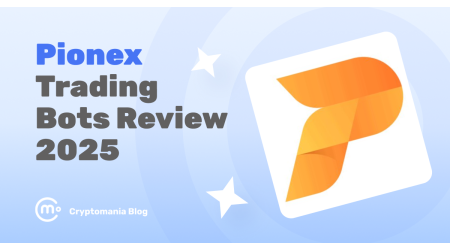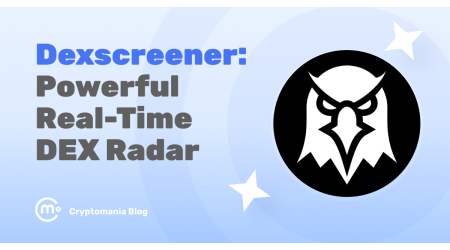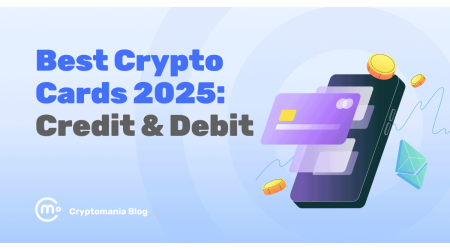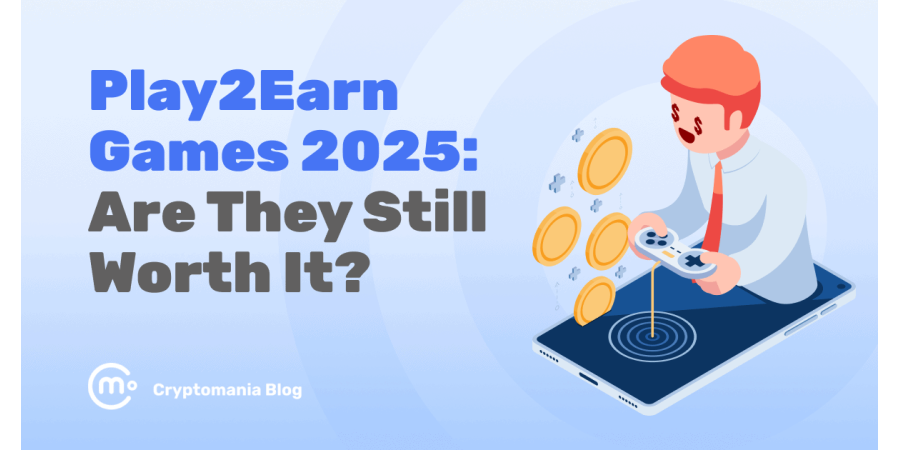

Play-to-earn games have come a long way since the first NFT experiments. In 2025, P2E crypto games are as speculative as they used to be 4 years ago. They’re polished, competitive, and often available on both PC and mobile.
But of course, not every title delivers. Some games build real, sustainable economies. Others still struggle with token inflation or clunky gameplay.
In this article, I’ll highlight the best play to earn games in 2025. You’ll see a mix of:
- Top play to earn games already dominating the market
- Play to earn mobile games you can run on Android or iOS
- A few upcoming projects with serious potential
If you want the best app to play games and earn money, or a full metaverse experience, or anything in between, these are the best play to earn crypto games to keep on your radar.
Top Play-to-Earn crypto games 2025
Below are my picks for the best play to earn games 2025. Each title has solid gameplay with real earning potential for PC, console, or Android and iOS.
- Axie Infinity – The flagship of play-to-earn, still thriving with NFT battles, land gameplay, and token rewards on the Ronin network.
- Illuvium – A polished AAA blockchain RPG where players capture Illuvials and earn ILV tokens through battles and exploration.
- The Sandbox – A metaverse where creators build, publish, and monetize experiences, earning SAND tokens from land and game content.
- Gods Unchained – A free-to-play trading card game rewarding skilled players with GODS tokens and NFT card ownership.
- Splinterlands – A blockchain card-battler that pays out DEC and SPS tokens through ranked matches, tournaments, and card rentals.
- Big Time – A co-op action RPG that lets players earn BIGTIME tokens and NFT cosmetics by raiding dungeons and crafting gear.
- Decentraland – A VR metaverse where users earn MANA by hosting events, trading assets, or developing on LAND NFTs.
- My Neighbor Alice – A social farming game where players can own virtual islands and earn ALICE tokens through community-driven gameplay.
Axie Infinity (Origins & Homeland)
Axie Infinity is still one of the most recognized names in play-to-earn. Built on the Ronin blockchain, it lets players collect, breed, and battle cartoon-like creatures called Axies.
Victories in PvP (player vs player) and PvE (player vs environment) modes reward Smooth Love Potion (SLP), while AXS acts as the governance and staking token.
After its explosive rise and later struggles with token inflation, the game has had major updates. The Origins battle system made combat more strategic, while the Homeland land gameplay opened new ways to earn through resource gathering and crafting.
In 2025, Sky Mavis is also testing Atia’s Legacy, an Axie-themed MMORPG that could further expand the ecosystem.
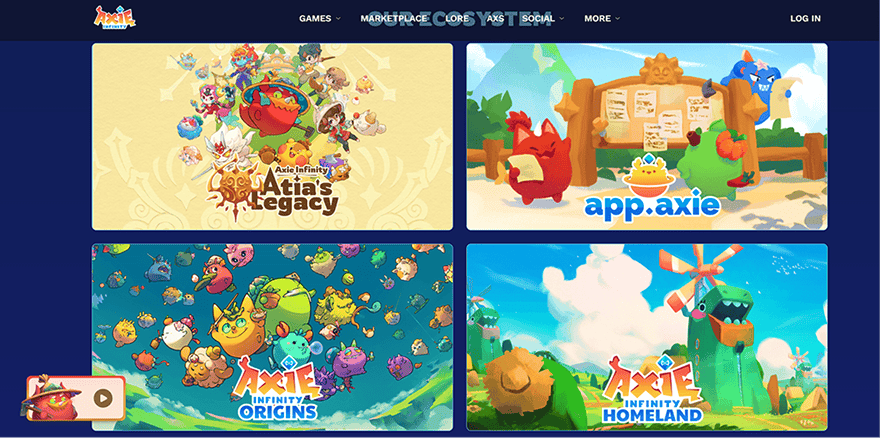
Entry is easier now than during the 2021 boom. Players can start for free with starter Axies (though earnings are limited) or invest in NFT Axies and land for full participation.
Pros
- Still the most recognizable P2E brand with a large community
- Multiple gameplay layers: Origins (battle), Homeland (land), and upcoming MMORPG
- Earn both SLP (in-game) and AXS (governance) tokens
- Backed by the Ronin blockchain with strong infrastructure
Cons
- Token inflation issues in the past still affect perceptions
- Requires NFT purchase for meaningful earnings
- Player base smaller than at its 2021 peak
- Earnings depend heavily on market demand for SLP
Illuvium
Illuvium is often called the first AAA-quality blockchain game, and for (mostly) good reason. Built on Ethereum, powered by Immutable’s layer-2 tech, it blends an open-world RPG with an auto-battler system.
Players explore alien landscapes, capture NFT creatures called Illuvials, and compete in battles for rewards.
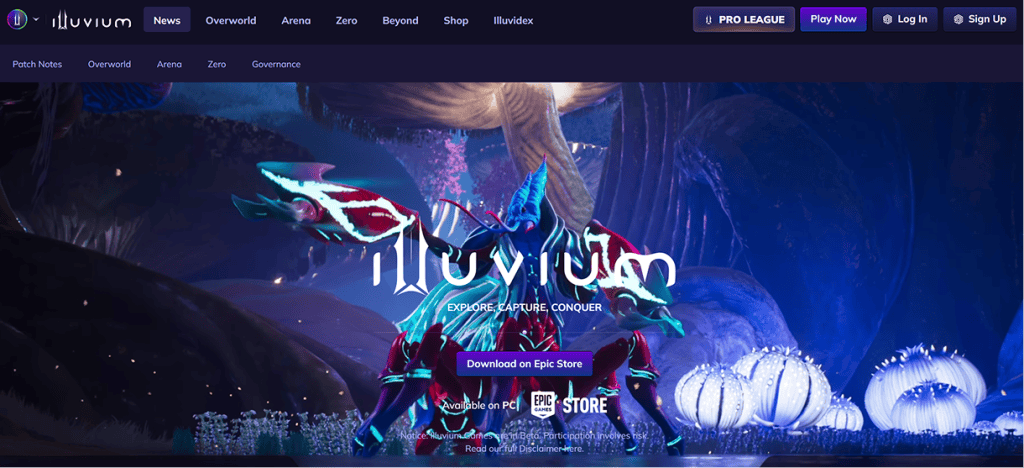
The game uses the ILV token for governance and staking, while sILV2 can be spent in-game. Illuvium’s economy is based on Illuvials themselves, scarce NFTs with different affinities, classes, and synergies that make battles more strategic.
If you’re not into PvP, the Overworld mode focuses on exploration, resource gathering, and creature hunting.
In 2025, there are esports-style competitions like the Illuvium Pro League (prize pools reach hundreds of thousands of dollars). The free-to-try model via the Epic Games Store has also opened the door to mainstream gamers who might not have touched crypto otherwise.
Pros
- AAA-quality graphics and gameplay uncommon in crypto gaming
- Multiple modes (Overworld, Arena, Zero) catering to different playstyles
- ILV token rewards plus NFT Illuvial ownership
- Available free on the Epic Games Store, lowering entry barriers
- Competitive esports scene with big prize pools
Cons
- Still in active development; some features are in beta or evolving
- Requires decent hardware, limiting accessibility for casual players
- NFTs and tokens can be expensive if aiming for high-level play
- Complex mechanics may overwhelm beginners compared to simpler P2E titles
The Sandbox
The Sandbox has slowly become a veteran in metaverse-style play-to-earn. Built on Ethereum with Polygon support for cheaper transactions, it’s a virtual world where players can own digital land, build custom experiences, and monetize them for SAND tokens.
In 2025, the platform continues to attract mainstream brands and artists, hosting events and collaborations that drive new traffic. The Builders’ Challenge program even rewards creators directly. It offers tens of thousands of SAND tokens for top experiences.
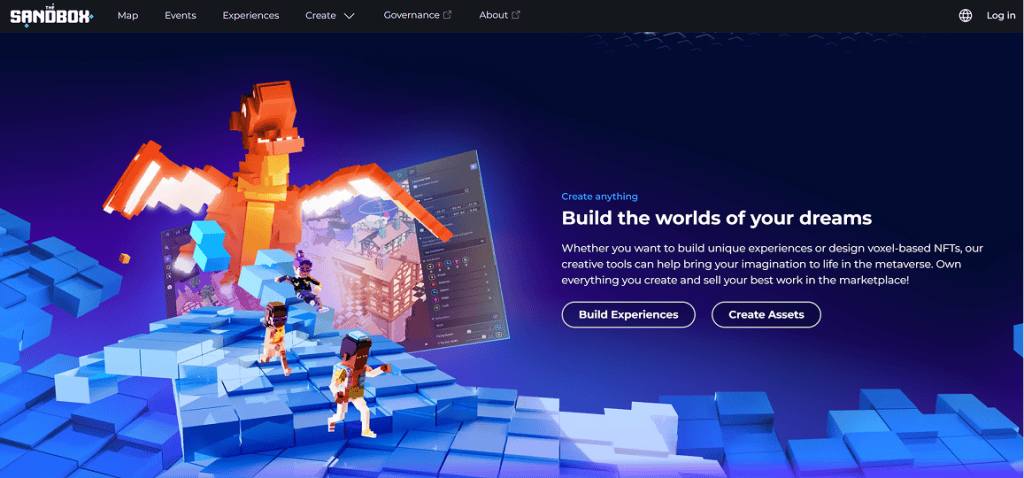
For players, exploring user-made games is free, while creators and investors can purchase LAND NFTs to host their projects. The dual appeal (play casually or invest and build) keeps The Sandbox relevant in the list of top play to earn games.
Pros
- Strong partnerships with mainstream brands and IPs
- Earn SAND tokens by building, hosting, or participating in events
- Free-to-play for explorers; big upside for LAND owners
- Active creator rewards programs like Builders’ Challenge
- Runs on Polygon for lower fees
Cons
- LAND and premium NFTs remain expensive for newcomers
- Still feels more like a creative platform than a traditional game
- Earnings potential varies heavily depending on creativity and visibility
- Requires time investment to build and monetize content
Gods Unchained
I don’t like card games. I played The Witcher 3 without ever trying Gwent. But I have to recognize Gods Unchained as one of the most popular games. It runs on Immutable’s scaling tech, meaning fast, low-cost transactions, and in 2025 it has fully migrated to Immutable zkEVM, which improves speed and liquidity.
Gods Unchained is completely free-to-play. New players get a starter deck right away, and as they win matches or climb ranked ladders, they can earn GODS tokens and NFT cards. These cards can be traded on secondary markets or used to upgrade your deck, giving skilled players a clear path to real rewards.
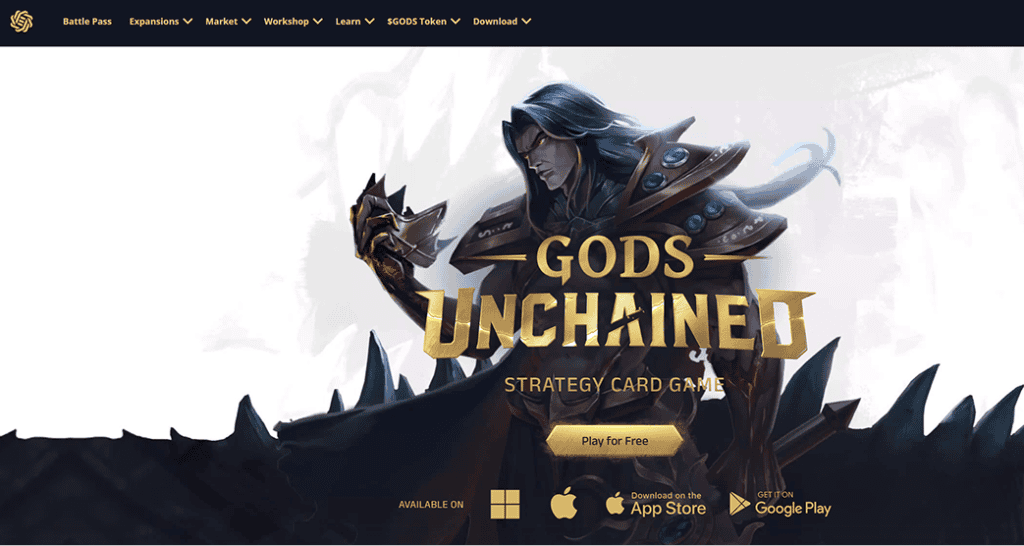
The game has also expanded onto mobile, with an official Android app available on Google Play and iOS support in rollout. This makes it one of the most accessible play to earn mobile games in 2025.
Pros
- 100% free-to-play entry with no NFT purchase required
- Earn GODS tokens and trade NFT cards through gameplay
- Now available on Android and iOS, widening access
- Familiar TCG gameplay that appeals to traditional card gamers
- Regular updates and balance patches keep the meta fresh
Cons
- Earnings are modest unless you play competitively
- Token value fluctuates with broader crypto markets
- RNG (luck of card draws) can frustrate casual players
- Less content variety compared to metaverse or RPG-style P2E games
Splinterlands
Splinterlands is another trading-card style blockchain game, but their approach is interesting. Instead of playing cards in real time, players build a team before each battle and let the match auto-resolve based on strategy and card synergies. It’s faster-paced and more accessible, especially for mobile users.
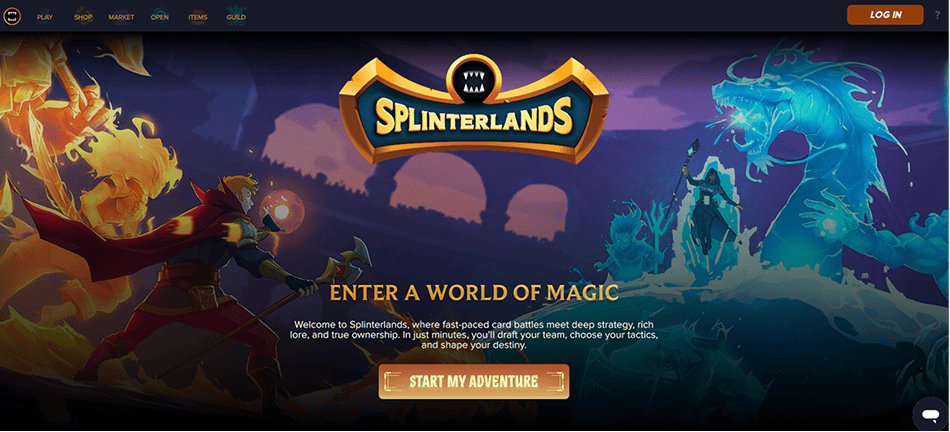
The game runs on the Hive blockchain and uses two tokens: Dark Energy Crystals (DEC) as the in-game currency and Splintershards (SPS) as the governance token. Players earn DEC by competing in ranked battles, daily quests, and tournaments, while staking SPS can boost rewards and provide voting power in governance.
Splinterlands has built one of the most active communities in crypto gaming, with consistent updates and low entry costs compared to bigger titles. Card rentals also allow beginners to compete without spending heavily.
Pros
- Low-cost entry with card rental options for beginners
- Earn DEC through battles, quests, and tournaments
- SPS staking adds governance and extra rewards
- Strong, long-standing community with daily activity
- Fast-paced auto-battle system easy to play on mobile
Cons
- Graphics and gameplay are simpler compared to AAA P2E titles
- Requires strategy and deck-building knowledge to be competitive
- Earnings potential tied to active play and staking
- Token values fluctuate with broader market sentiment
Big Time
Big Time is one of the most polished action RPGs in the blockchain space, and it’s completely free-to-play. If it didn’t suffer from occasional laggy servers, I’d play it even if it wasn’t P2E.
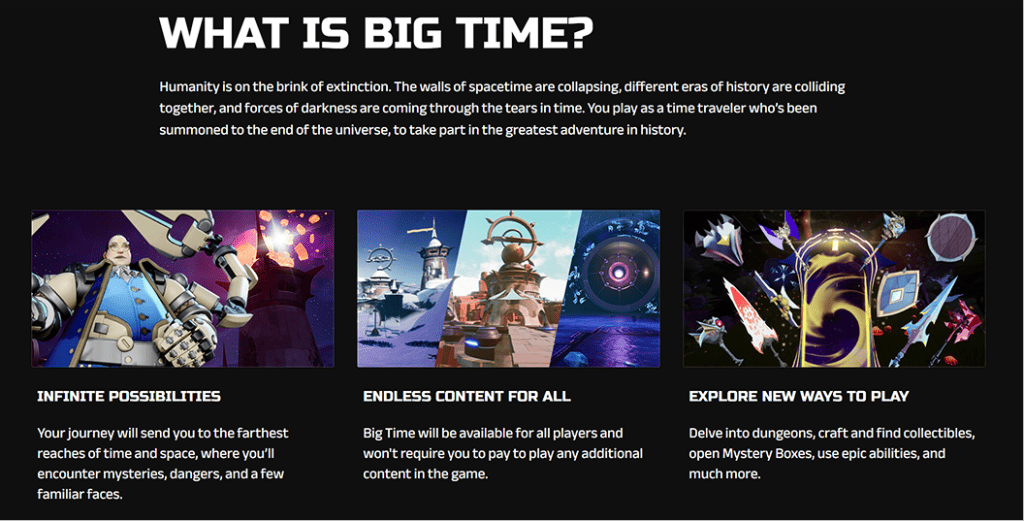
Players team up in co-op dungeon raids, battling enemies, collecting loot, and crafting items. The in-game economy is powered by the BIGTIME token, which ties into crafting and upgrading NFTs like weapons, armor, and cosmetics. Players can also trade rare drops in secondary markets, giving the game a loot-driven earning model similar to traditional MMOs.
Because earnings are based on gameplay and item utility rather than just speculation, Big Time has built a reputation for being more sustainable than earlier P2E experiments.
In 2025, Big Time continues to expand with seasonal updates, new dungeons, and community events that keep players engaged.
Pros
- Free-to-play entry with no upfront NFT purchase required
- Earn BIGTIME tokens and NFT cosmetics through raids and crafting
- High-quality graphics and co-op dungeon gameplay
- Regular content updates keep the game fresh
- Strong reputation as a skill-based, not pay-to-win, P2E
Cons
- Token value depends on demand for crafting and cosmetic items
- Still PC-only, no official mobile support yet
- Requires time investment to unlock high-value drops
- Not as beginner-friendly as simpler mobile or card-based P2E games
Decentraland
Decentraland is one of the earliest blockchain-based metaverses, and still a major play-to-earn player. Built on Ethereum, it gives users the ability to buy, own, and develop virtual land parcels (LAND NFTs).
Players can then monetize those parcels by hosting events, creating experiences, or trading assets on the open market, all tied to the MANA token.
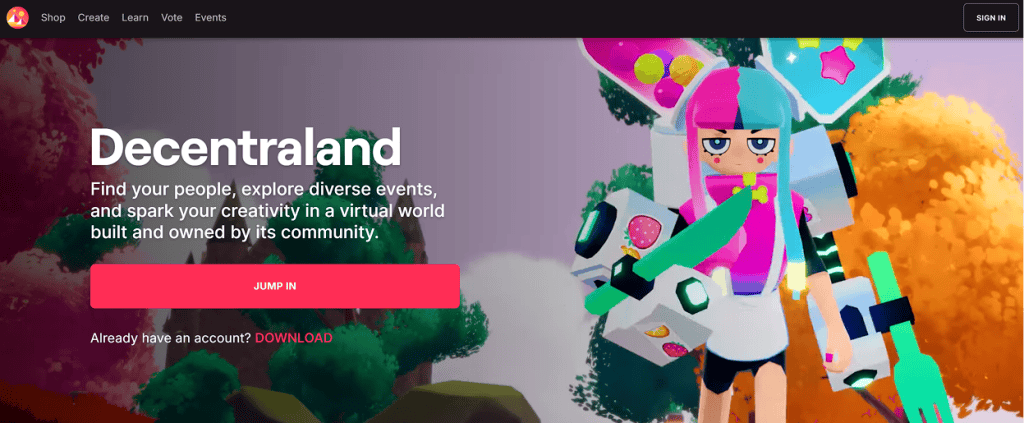
By 2025, Decentraland has solidified its role as a social hub. It often hosts crypto conferences, art festivals, and brand-sponsored events. Unlike most P2E titles focused on battles or farming, it leans heavily into community-driven content. Players can generate income from creativity and networking rather than combat.
The platform remains free to explore, but meaningful earnings usually require owning or renting LAND, making it more attractive to creators and investors than casual players. Still, its longevity and decentralized governance keep it at the forefront of top play to earn games.
Pros
- Long-standing metaverse with strong community and brand recognition
- Multiple ways to earn: events, asset trading, LAND leasing, and MANA staking
- Free to explore; player-driven content keeps the world dynamic
- Decentralized governance ensures community input on growth
- Regularly hosts real-world style events with crypto rewards
Cons
- LAND NFTs and premium assets can be expensive
- Graphics and gameplay feel dated compared to newer P2E titles
- Best suited for creators and investors, less so for pure gamers
- Earnings depend on visibility and event attendance
My Neighbor Alice
My Neighbor Alice is a social farming and building game built on the Chromia blockchain. Think of it as a mix between Animal Crossing and blockchain ownership: players can buy and customize virtual islands, grow crops, raise animals, and interact with neighbors.
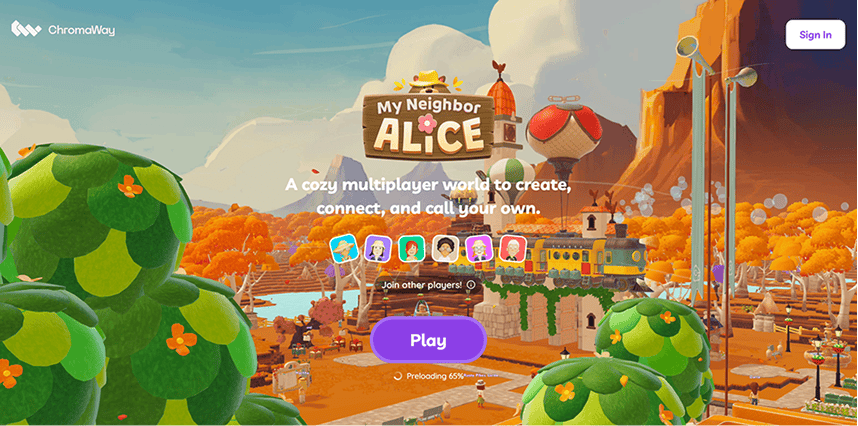
The economy runs on the ALICE token, which is used for land ownership, in-game purchases, and governance.
In 2025, the game continues to stand out as one of the more casual-friendly play to earn games. Unlike competitive card games or high-end RPGs, My Neighbor Alice appeals to a broader audience. Events and quests keep things active, while NFT-based land and items give players a path to real-world rewards.
Pros
- Accessible gameplay similar to Animal Crossing, with broad appeal
- Earn ALICE tokens through farming, quests, and land ownership
- Strong emphasis on community and social interactions
- Runs on Chromia blockchain with scalable infrastructure
- Attractive option for casual players entering P2E
Cons
- Earnings are slower and smaller compared to competitive P2E titles
- Requires land or NFTs for full earning potential
- Graphics and mechanics are simple, may not appeal to hardcore gamers
- Smaller player base compared to giants like Axie Infinity or The Sandbox
Is Play-to-Earn still worth it in 2025?
Play-to-earn gaming has matured since the hype cycles of 2021. Back then, many projects promised life-changing income, but then collapsed under unsustainable tokenomics.
In 2025, things are different. Established titles, like Axie Infinity, Illuvium, and Splinterlands now focus on gameplay first, with rewards structured to be more sustainable.
That said, P2E is not a guaranteed income stream. Tokens and NFT values remain tied to volatile crypto markets, and rewards often shrink as more players enter the game.
My suggestion is to see earnings as a bonus: a way to offset gaming costs or earn small amounts of crypto. It’s certainly not something to replace people’s jobs, or provide significant income.
The safer approach in 2025 is to treat P2E games as entertainment first. If you enjoy the gameplay, rewards add an extra layer of value. But if you’re going in purely for profit, there’s a good chance you may be disappointed.
Parting thoughts
The play-to-earn ecosystem in 2025 looks very different from the early days of NFT pets and speculative farming. Today’s best P2E crypto games cover a wide range of genres.
If you’re looking for proven titles, games like Axie Infinity, Illuvium, and The Sandbox continue to lead the way. For casual players, options like Gods Unchained, Splinterlands, and My Neighbor Alice make it easy to get started without a big upfront cost. And if you’re after sheer scale, infamous Hamster Kombat shows just how massive play-to-earn mobile games can get and how fast they can go down.
No matter what you choose, remember that earnings vary by game, market conditions, and the time you’re willing to invest. The safest approach is to play games you genuinely enjoy.


